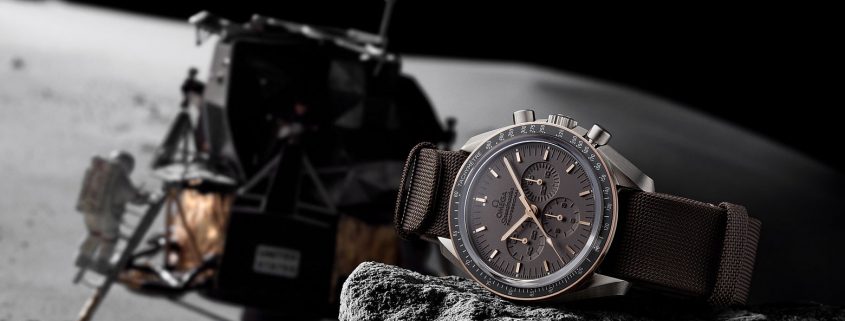The OMEGA Speedmaster And The World Of Space Exploration
OMEGA Speedmaster – The First Watch On The Moon
Today, I’m writing about an important piece of history: the OMEGA Speedmaster. OMEGA’s history with space exploration is more than that, but let me explain it…
Many cultures around the world have interesting myths about the Moon, reflecting it’s presence in the night sky and its impact on our lives. Since human kind started to explore, we have the desire to fly to the moon. Neil Armstrong’s quote couldn’t be better associated with my story today:
“That’s one small step for man, one giant leap for mankind”
At the same time, it’s a huge achievement to develop the first watch worn on the moon.


The OMEGA Speedmaster Moonwatch
The source of many a myth and legend, the OMEGAt Speedmaster has been the choice of astronauts and space agencies for half a century. This “common” object has become one of the most famous watches in the world and has been associated with the entirety of humankind’s half century of space faring, thus earning it the name “The Moonwatch”.

OMEGA’s history with space exploration began sometime in 1962 when a group of astronauts including Walter “Wally” Schirra and Leroy Gotdon “Gordo” Cooper privately purchased their very first flight-watches: the 2nd generation Speedmaster model with the reference CK2998. These privately owned chronographs were to be used on the upcoming Mercury program flights. And indeed, the very first time that a OMEGA Speedmaster flew on a space mission was “Wally” Schirra’s own CK2998 during the Mercury-Atlas 8 (callsign: Sigma 7) mission.
Two and a half years later and after a series of what can only be described as radical, extreme and exceptionally brutal tests, the choice of the Mercury astronauts became the choice of NASA.
It was at the end of the Mercury program that the astronauts approached the Operations Director, Deke Slayton, and asked to be issued with a watch for use during training and eventually flight. This request was met with enthusiasm and as every piece of equipment from the Mercury program was being re-evaluated and re-designed for the upcoming Gemini and Apollo programs, the timing could not have been better. NASA had just employed a large group of engineers to test, select and certify equipment to be used by the astronauts.
On the 21of September, 1964, Slayton issued an internal memo stating the need for a “highly durable and accurate chronograph to be used by Gemini and Apollo flight crews”. This memo landed on the desk of engineer James Ragan who was no newcomer to finding equipment for hostile environments. He had been the engineer responsible for testing equipment for the US Navy’s “SEA LAB” program. Eight days later a “Request for Quotations” for wrist chronographs was sent out to different manufacturers. OMEGA’s copy of the Request was received by its U. S. affiliate in New York. Of brands contacted, only four responded so James Ragan asked each to supply three watches.

But What Tests Needed To Be Fulfilled?
The tests which ensued were designed literally to test the watches to destruction. The watches were subjected to temperatures ranging from 71° to 93° centigrade over a two day period, after which they were frozen to -18° centigrade. They were placed in a vacuumed chamber heated to 93° centigrade, and then subjected to a test where they were heated to 70° centigrade and then immediately frozen to -18° centigrade – not once but fifteen times in rapid succession! When this had been completed, it was time to subject the watches to 40 g shocks in six different directions, then submit them to high and low pressures, an atmosphere of 93% humidity, a highly corrosive 100% oxygen environment, noise to 130 decibels and finally vibrated with average accelerations of 8.8 g. In the end only one watch had survived: the Speedmaster. Interestingly, after each test the watch would settle to an average rate which was largely within the NASA imposed limits of five seconds per day during normal use.
The result of this was the “Speedmaster” reference ST105.003 being declared “Flight Qualified for all Manned Space Missions” on the 1st of March 1965. Just three weeks later, on the 23rdof March, the Speedmaster went into space officially for the first time on the wrists of Virgil “Gus” Grissom and John Young during their Gemini 3 mission. The only modification to the watches was the addition of a long Velcro strap that replaced the standard steel bracelet which could not be worn over the space suit. Later that year Edward White wore his Speedmaster on America’s first space walk, during the Gemini IV mission.
Another four years passed and the Americans were preparing for the first lunar landing. The crew had been selected and the decision was made that Neil Armstrong would be the first man to walk on the moon’s surface. NASA had, by this point, adopted the most recent version of the Speedmaster, the ST105.012 and ST145.012 for the Apollo program; however, as NASA still had quite a few ST105.003 in stock out of the original procurement, this model was also routinely issued to the astronauts.


OMEGA Speedmaster – The First Watch Worn On The Moon
On the 21stof July 1969 at 2:56 GMT, Neil Armstrong stepped off the Eagle to become the first human to stand on another world. Roughly fifteen minutes later Buzz Aldrin stepped onto the Moon’s surface too and thus, during the legendary Apollo 11 mission, the Speedmaster Professional became the first watch to be worn on the Moon.
The next great moment for the Speedmaster in space came in 1970 with the Apollo 13 mission, when the watch was used to time the critical engine burns needed to ensure that the re-entry trajectory of the heavily damaged craft were correct. The smallest error would have meant that the capsule would either have bounced off of or burnt up in the Earth’s atmosphere on re-entry. For The Speedmaster Professional’s role in the safe re-entry, the astronauts gave OMEGA the coveted Silver Snoopy Award that is accompanied with its certificate bearing the inscription “Manned Flight Awareness Award”, the highest distinction given by NASA and its astronauts to private persons or companies in appreciation for important services rendered for the American Space Program.


My Personal OMEGA Speedmaster
Of course, I own an OMEGA Speedmaster. Not only because of it’s most precise movement or it’s amazing look. The moon has inspired me since I’m able to speak. One of my first words I knew, was ‘moon’ – a story my mother loved to narrate. My Speedmaster now goes around the world…









amazing article, I have a speedmaster too!
the first watch worn on the moon! the omega speedmaster is history!
the omega moonwatch is a unique timepiece I absolutely adore!
I own an omega speedmaster dark side of the moon and I’m super happy with it!